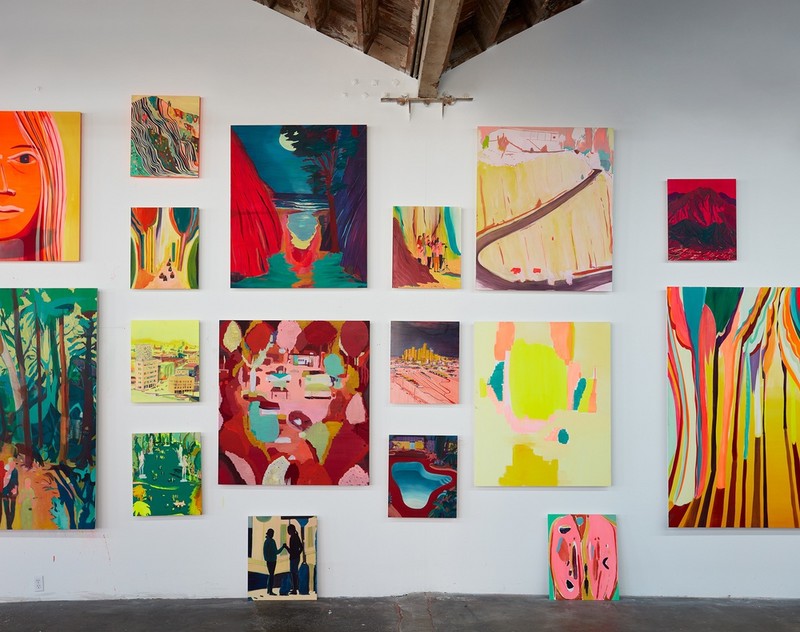Jules de Balincourt
14 Apr - 14 May 2016
JULES DE BALINCOURT
Stumbling Pioneers
14 April - 14 May 2016
Victoria Miro presents Stumbling Pioneers, the second solo exhibition at the gallery by Jules de Balincourt, which explores the frontier as a charged concept in contemporary culture. Painted on return to his hometown Los Angeles after a 20-year interval, these works road-trip through the mythic and geographically sprawling metropolis with an eye for man’s uncertain relationship with his environment.
Perched on the shores of the Pacific Ocean, Los Angeles has, since the pioneering age, been the limitless repository of America’s dreams of the frontier, of desires that saturate the sunsets, freeways, canyons and swimming pools that de Balincourt paints. This landscape, a disjunctured synthesis of the human, the architectural, and the organic, seems to temper idealistic energies: rather than striding boldly into the unknown, the figure drifts aimlessly through sunlit pockets of space, leisurely waiting for some ultimate opportunity for freedom. Here, the promise of the frontier – the hope of progress and the better life it inspires – coexists with a muddled reality of blurred boundaries between man and nature in a landscape that seems comprehensively colonised.
Poised between the strange and the familiar, the works that make up Stumbling Pioneers are rooted in the unmistakeable vibrant landscape of California, yet shaped by dreamlike associations that interconnect large-scale canvases and smaller works. Almost-transparent washes of paint build gradients of colour and form on these carefully constructed surfaces, on which the abstract remains visible amidst defined areas of representation. De Balincourt’s work gestures towards the incalculable process of painting, which he has described as beginning with, ‘a very intuitive dance in the dark of brushes and pigments [...] So in a way it is about this intersection in my mind when I abandon the more unknowing primitive approach, finding something that inspires or I need to pursue.’
De Balincourt’s practice occupies a distinct emotional hyperspace, ranging with easy fluency across abstraction and figuration, collective imagination and singularised perception to make idiosyncratic connections within the landscape of contemporary westernised culture. Hard and fast dualities, whether psychological or sociopolitical, are suspended in this shifting space: together, his works invite us to journey across terrain in which it is no longer easy to distinguish between the utopian and the dystopian, the escape and the capture.
Stumbling Pioneers
14 April - 14 May 2016
Victoria Miro presents Stumbling Pioneers, the second solo exhibition at the gallery by Jules de Balincourt, which explores the frontier as a charged concept in contemporary culture. Painted on return to his hometown Los Angeles after a 20-year interval, these works road-trip through the mythic and geographically sprawling metropolis with an eye for man’s uncertain relationship with his environment.
Perched on the shores of the Pacific Ocean, Los Angeles has, since the pioneering age, been the limitless repository of America’s dreams of the frontier, of desires that saturate the sunsets, freeways, canyons and swimming pools that de Balincourt paints. This landscape, a disjunctured synthesis of the human, the architectural, and the organic, seems to temper idealistic energies: rather than striding boldly into the unknown, the figure drifts aimlessly through sunlit pockets of space, leisurely waiting for some ultimate opportunity for freedom. Here, the promise of the frontier – the hope of progress and the better life it inspires – coexists with a muddled reality of blurred boundaries between man and nature in a landscape that seems comprehensively colonised.
Poised between the strange and the familiar, the works that make up Stumbling Pioneers are rooted in the unmistakeable vibrant landscape of California, yet shaped by dreamlike associations that interconnect large-scale canvases and smaller works. Almost-transparent washes of paint build gradients of colour and form on these carefully constructed surfaces, on which the abstract remains visible amidst defined areas of representation. De Balincourt’s work gestures towards the incalculable process of painting, which he has described as beginning with, ‘a very intuitive dance in the dark of brushes and pigments [...] So in a way it is about this intersection in my mind when I abandon the more unknowing primitive approach, finding something that inspires or I need to pursue.’
De Balincourt’s practice occupies a distinct emotional hyperspace, ranging with easy fluency across abstraction and figuration, collective imagination and singularised perception to make idiosyncratic connections within the landscape of contemporary westernised culture. Hard and fast dualities, whether psychological or sociopolitical, are suspended in this shifting space: together, his works invite us to journey across terrain in which it is no longer easy to distinguish between the utopian and the dystopian, the escape and the capture.

